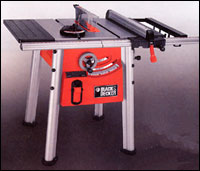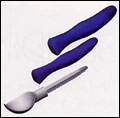Amy Castor, Contributing Editor

Some companies hire outside design firms to collaborate on projects.
Black&Decker designed the top half of this table saw and outsourced the
bottom half to Bresslergroup. |
|
Many companies know that doing everything themselves is not always the best
business decision.
Sometimes finding the experts to do a specific aspect of design or
manufacturing is the more economical-and ultimately profitable-route to take. When a company outsources, they can focus on their own core competencies, devote more time to their customers, and move products out the door faster.
What gets outsourced depends on a company's areas of expertise and how many hands it has on deck. There are numerous ways to divvy up the work. Companies can outsource any part of industrial or
mechanical design or manufacturing. They can even split a design down the middle. That's how Black & Decker worked with full
service design company Bresslergroup (Philadelphia, PA) on a table saw.
"It was a real collaboration," says Mike Flanagan, marketing director for Bresslergroup. "We were hired to
supplement their needs. They designed the top of the table and we handled the base."
In many cases, companies will hire an outside firm to handle the whole kit and caboodle, from concept through
production. If a company has its own production facilities or a strong existing
relationship with a manufacturer, a contract firm may skip end production but handle material specification and specking of components. The contractor can even do matchmaking, helping to set customers up with toolmakers, injection molders, stampers, and die casters.
More hands on deck
There are a slew of reasons why companies decide on outsourcing product design, but limited internal resources is one of the biggest. If a company is not pumping out new product regularly, it doesn't make sense to maintain a full-time design
staff.
"There are Apples and Ciscos out there who are creating new products all the time," says David Law, president of Speck Product Design (Palo Alto, CA), a design and engineering contract firm. "But
smaller companies tend to focus on making incremental improvement to existing products in order to keep things fresh."
Product design outsourcing is not limited to the little guys. Big companies need the additional peoplepower and expertise at times, too. In fact, most of his company's business comes from large corporations with a full engineering staff that are short on industrial designers, says Bresslergroup's
Flanagan.
Robert Freid, president of Contract Manufacturing Consultants
(Bellevue, WA), helps companies fine tune their outsourcing strategies. He says that companies tend to favor outsourcing product design and development if the design is for a low-end product relative to their other offerings, if the product requires design for manufacturability tests that are not available in house, or if a design falls outside of its core competency.

CISCO SYSTEMS' CORE COMPETENCY is electrical engineering, so it turned to Speck Product Design when it needed a mechanical design for its 1 2000 series gigabyte switch router.
Internet giant Cisco Systems turned to Speck Design for the latter when it needed a design for its 12000 series gigabyte switch router. Cisco's core competency is electrical engineering, not mechanical design, so it called on Speck to design the chassis for the router. They also needed the additional labor. "Cisco develops lots and lots of products," says Law, "and essentially, they get so bogged down that the only way to gather a team is to outsource."
Outsider's perspective
There's another benefit to outsourcing product design and development that's not so obvious: An outsider who is not mired in a company's politics and culture can shed new light on a product's design.
"When people are close to a product, they tend to think the product should be the way that it's always been," Law says. "Sometimes we're able to ask the dumb questions, take a fresh look at the
market, and come up with ideas they may not have come up with internally."
Outsiders can also introduce new design paradigms. Flanagan of Bresslergroup says that clients often come to him when they want to leap into a new product category. "Either they have no experience in the area or they've been doing it forever and just need someone to kick it to the next level," Flanagan says.
Cutco, a company that makes cutlery and other kitchen tools, approached Bresslergroup when it needed a line of cooking tools that didn't look like the old line. Bresslergroup designed a cheese knife, an ice-cream scoop, and several other products for them. "They were fully capable of having developed everything internally," says Flanagan, "but by their outsourcing product design we brought in a different point of view; a different
style."

OUTSIDE DESIGN FIRMS CAN BRING a fresh look to products. Cutco, a cutlery company, turned to Bresslergroup for the design of its new ice-cream scoop.
Producing it elsewhere
Outsourcing extends to manufacturing as well, but the benefits are different. Companies look to contract
manufacturers to bear the financial risk since manufacturing internally requires a huge investment in production and test
equipment and raw materials.
"Typically you have to keep a couple of months of inventory in stock to draw from in order to manufacture your
product," says Freid of Contract Manufacturing
Consultants. "With a contract manufacturer doing that for you, you just put in an order for a
product, which you can immediately turn around and sell."
Time to market is also an appeal for start-up companies. By outsourcing
production they can get product rolling out the door faster.
But contracting manufacturing is not for everyone, Freid says, who offers
feasibility assessments for his clients. "If the outsourcing value is small relative to the number of mechanical assemblies, that's not a program that's going to be
attractive," he says. OEMs should also think twice if a product requires lots of changes or complex systems
manufacturing. Another consideration is the additional material cost. In order to meet their objectives, contract manufacturers need to mark up material costs by as much as 10%, according to
Freid.
Whether it is to cut costs, speed time to market, or get a new angle on a product design, many companies are outsourcing product design as a strategy to handle much of the work that was normally done in-house.
Copyright © 2003 Design
News



